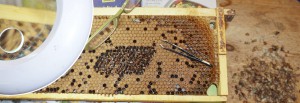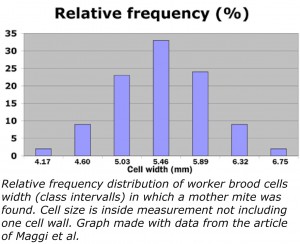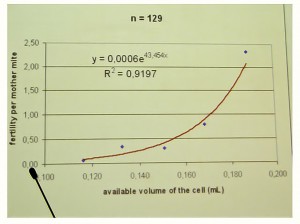There have been numerous tests of varroa reproduction with bees on different cellsizes throughout the years, with the assumption that you then test varroa resistance. As far as I understand that can be true, but you don’t know to what degree it is true. One thing is clear – testing varroa reproduction is focusing on mite behavior, not on bee behvaiour. Bee behavior is for example VSH (http://www.elgon.es/diary/?p=146).
 VSH test in 2014. I use a reading glass with lens lamp plus a pair of reading glasses 2.5+ and tweezers.
VSH test in 2014. I use a reading glass with lens lamp plus a pair of reading glasses 2.5+ and tweezers.
Leaving out bee behavior when trying to understand varroa resistance is not a good choice. But mite reproduction is also interesting if you want to get full understanding of Varroa resistance. For the practical beekeeper though the easiest is to focus on VSH, maybe measuring mite population once or twice a year (http://www.elgon.es/diary/?p=354) (http://www.elgon.es/diary/?p=365) and listening to nature to get the fittest kind of bees, using small cells at least in the brood nest (http://www.elgon.es/diary/?p=224) (http://www.elgon.es/diary/?p=119).
What about mite reproduction in small cells? At first when mites arrive in an area, mites reproduce well enough to grow very big mite populations, also in colonies with small cells, in South America and in South Africa – and with me. But after 5-6 years the bees have developed what is recognized as mite resistance. Maybe with me too soon, this is the fifth year and I have seen very promising results.
The best reproduction test
The best test on mite population growth in different cell sizes I find “Brood cell size of Apis mellifera modifies the reproductive behavior of Varroa destructor”, by Matı´as Maggi, Natalia Damiani, Sergio Ruffinengo, David De Jong, Judith Principal and Martı´n Eguaras in Exp Appl Acarol (2010) 50:269–279 (http://www.ncbi.nlm.nih.gov/pubmed/19768560).
It’s a test under natural conditions, not a designed test. The scientists have collected data during a natural condition, well, a natural beekeepers condition of today. But they didn’t treat for varroa the 18 months before the data collection to have an enough big varroa population to get reliable data. I think the paper is interesting enough for anyone interested to buy the full text. It contains a good discussion, which reveals a lot of knowledge on the subject.
The test confirms other tests showing that Varroa mites prefer bigger cells. This test also shows that the distribution of mites in the brood with different sizes of cells is in line with that preference, the smaller the cell size the less probability that the cell is infested with a mite.
But what then if there are only small cells in a brood nest – would the Varroa population grow at the same rate as if there were only large cells. That’s the really interesting question to get an answer to. That’s not what this test tried to get an answer to. But there is an interesting discussion in it.
They took a capped brood frame from a number of colonies, uncapped all brood and registered and measured all cells with mites. When a colony in this test had a comb with different cell sizes the reason was that it was such an old comb that the bees had reworked the comb with patches of smaller cell sizes. Also old combs had smaller cell sizes due to a lot of cocoon residues. Some of the brood combs tested came from combs relatively newly drawn from foundation with 5.4 mm cell size imprint (personal information).
The colonies had a mite infestation between 16 and 63 % in the worker brood. So the group of colonies did not form a resistant stock. The more resistant colonies (with lower infestation) would have big problems with reinfestation from more susceptible ones if all were left untreated in the same apiary.
Why do mites avoid smaller cells?
Why did mites avoid cells with smaller size? Probably because they and their daughters will become infertile quicker in those. Last sentence in the abstract:
“Infertile mother mites were more frequent in narrower brood cells.”
There is a discussion why this is so. A probable answer is the food for the mites. They feed on larvae and pupae and bees. Larvae in smaller cells get different food, the phenotype becomes different. This is a logical explanation why mites are more attracted to larvae in bigger cells. The food is tasting better there and is more nourishing for the mites giving them a longer and more fertile life.
Yves Le Conte
In a lecture in Versaille in France 2006 on the SICAMM conference, the association for breeding the dark honeybee Mellifera mellifera, Yves Le Conte showed the graph on the picture here, taken by a Swiss beekeeper attending. The graph shows results from tests LeConte had done (most probably involving the varroa resistant feral stock he is working with), showing a decrease in fertility for mites in cells with smaller volume.
This is almost the same as saying cells with smaller cell size. It’s just adding the depth of the cell to the bottom area (“cell size”, mm between the parallel sides of the cell, is a way of presenting the bottom area of the cell). Maybe this also indicates that the distance between the combs might influence if it’s narrow enough to give shorter cells. If the distance between the combs are bigger than necessary the depth of the cell will though not be bigger. The space to the other comb will though be bigger if on that side there is brood as well. The results of Le Conte and Maggi et. al. are confirming each other.
“Infertile mother mites were more frequent in narrower brood cells.”
Mites don’t lay eggs forever. After a number of rounds in capped brood cells laying eggs (about three normally) their fertility is over. Next time they enter a brood cell they are infertile, lay no eggs.
Fewer rounds in smaller cells you might well don’t see in a short test, all those tests from two and a half month to a year that have been done. Especially if large cell control colonies are close by sharing their mites, more the higher the mite population grow.
In an area with only small colonies then, why did the mites develop at all so heavily, in the beginning few years (with no or relatively little treatment)? Good question. Evidently some kind of adaption to the presence of mites had to take place. It seems the bees had to learn how to chase the mites. They developed better hygienic type of behavior against the mite, both a general reaction against mite infested brood and a more specialized like VSH (where only mites with offspring are cleaned out of brood). On top of that genetic selection that favor these behaviours.
When queens from resistant feral bees from France were tested in Canada against “native” stock the result showed no difference. The queens were introduced in bee colonies that hadn’t learned how to deal with the mite because the mite pressure was in general to low, the bees were on large cells, the control colonies were to close to the test colonies sharing mites and the test period was too short.
Could some of the VSH-result obtained in small cell bees be caused of or explained by the small cells? Are the small cells helping the bees and the beekeeper finding the VSH trait in the selection process? Will good VSH queens on small cells not give so good VSH bees on large cells? Or to put this another way.
Do small cells contribute in expressing the VSH trait through making the mites infertile quicker? The results of Yves Le Conte and Maggie et.al. indicate that.
Are the more phenotypic changes from small cells that have impact on resistance against varroa and viruses?


Hace 7 años que tengo 22 colmenas en 4,9 y al principio les costo un poco eliminar la varroa pero en la actualidad se defienden de maravilla.
Translated into English:
“7 years ago I had 22 hives on 4.9 and initially it cost me a little to eliminate varroa but today I’m a great advocate.”
Another comment by mail:
Referring to the depth of the cells.
you write:
This is almost the same as saying cells with smaller cell size. It’s just adding the depth of the cell to the bottom area (“cell size”, mm between the parallel sides of the cell, is a way of presenting the bottom area of the cell). Maybe this also indicates that the distance between the combs might influence if it’s narrow enough to give shorter cells. If the distance between the combs are bigger than necessary the depth of the cell will though not be bigger.
I think that the bees do not change the depth of the cells. There is a fixed correlation between cell width and cell depth.
You can see that the bees in 4,9mm plastic combs made in Italy by rovergarden do the capping below of the cell top because these plastic frames (similar to HSC) have 14mm depth (HSC 11mm):
http://www.resistantbees.com/plastik_e.html
look at this picture from Adriano, Italy:
http://apibio.it/Rovera2.JPG
http://apibio.it
Kind regards
Stephan
Yes Stephan, you explained that better than I did in the blogpost.